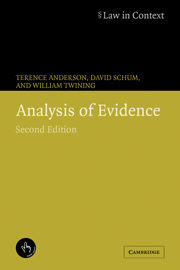Book contents
- Frontmatter
- Contents
- Preface
- Acknowledgments
- Tables of cases and statutes
- Table of legislation and rules
- List of abbreviations
- 1 Evidence and inference: some food for thought
- 2 Fact investigation and the nature of evidence
- 3 Principles of proof
- 4 Methods of analysis
- 5 The chart method
- 6 Outlines, chronologies, and narrative
- 7 Analyzing the decided case: anatomy of a cause célèbre
- 8 Evaluating evidence
- 9 Probabilities, weight, and probative force
- 10 Necessary but dangerous: generalizations and stories in argumentation about facts
- 11 The principles of proof and the law of evidence
- 12 The trial lawyer's standpoint
- Glossary of terms and symbols
- References
- Index
6 - Outlines, chronologies, and narrative
Published online by Cambridge University Press: 23 November 2009
- Frontmatter
- Contents
- Preface
- Acknowledgments
- Tables of cases and statutes
- Table of legislation and rules
- List of abbreviations
- 1 Evidence and inference: some food for thought
- 2 Fact investigation and the nature of evidence
- 3 Principles of proof
- 4 Methods of analysis
- 5 The chart method
- 6 Outlines, chronologies, and narrative
- 7 Analyzing the decided case: anatomy of a cause célèbre
- 8 Evaluating evidence
- 9 Probabilities, weight, and probative force
- 10 Necessary but dangerous: generalizations and stories in argumentation about facts
- 11 The principles of proof and the law of evidence
- 12 The trial lawyer's standpoint
- Glossary of terms and symbols
- References
- Index
Summary
The outline method of analysis and its variants are more familiar to practicing lawyers. They have the advantage that they are easier to use than the chart method, althoughit is harder to maintain the rigor that the chart method requires. In addition to these two methods of analysis, there are two analytic devices in common use, narratives and chronologies, that complement and facilitate the use of both methods of analysis. In Part A of this chapter, we describe and illustrate the outline method of analysis. In Part B, we describe the analytic devices and discuss their utility. In Part C, we discuss how and with what effect the methods and devices can be used at various stages of a litigated case. In Part D, we describe the essential tools by which the products of an analysis may be converted into forms useful to a lawyer at any stage of a case.
The outline method of analysis
One of the strengths of the outline method is its utility in organizing the evidence and arguments. In the outline, each of the penultimate probanda is a main heading in the outline. For example in the Simpson case, the outline would begin:
I NBS is dead.
II NBS died as the result of an unlawful act.
III It was OJS who committed the act that caused NBS's death.
IV The person who committed the acts that caused NBS's death acted with malice aforethought.
Given the prosecution's provisional theory of the case, the central fact in dispute was the third penultimate probandum.
- Type
- Chapter
- Information
- Analysis of Evidence , pp. 145 - 158Publisher: Cambridge University PressPrint publication year: 2005



